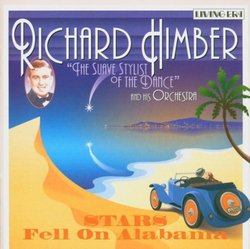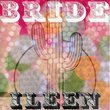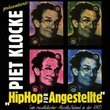| All Artists: Richard Himber Title: Stars Fell on Alabama Members Wishing: 1 Total Copies: 0 Label: Asv Living Era Release Date: 11/23/2004 Genres: Dance & Electronic, Jazz, Pop Styles: Swing Jazz, Dance Pop, Easy Listening Number of Discs: 1 SwapaCD Credits: 1 UPCs: 743625544022, 743625544022 |
Search - Richard Himber :: Stars Fell on Alabama
CD DetailsSimilar CDs
|
CD ReviewsDebonair dance music! Steven Phillips | Ada, OK United States | 02/16/2005 (5 out of 5 stars) "Richard Himber had one of the top "sweet" dancebands of the 1930s. Previously, he was first violinist for Rudy Vallee's Connecticut Yankees, and it was Vallee who encouraged and financed (a gift, not a loan) Himber's first orchestra. Himber's orchestra usually played in the most prestigious hotels and ballrooms and had access to the topflight musicians of his era - for recordings, if not for routine, nightly performances. Artie Shaw, Tommy Dorsey, Bunny Berigan, Blue Barron, and other future bandleading notables are among the sidemen on the recordings of this CD. Also, Himber featured two highly popular and effective vocalists: Joey Nash, a tenor; and after 1934, Stuart Allen, who had a suave, musically dramatic, and modern-sounding baritone voice. Himber had an ebullient personality and was notorious for springing practical jokes on well-known patrons or celebrities. He was also an accomplished magician who invented a number of tricks or gadgets still in use today - such as the Himber wallet. The most representative orchestration on the CD's tracks included two trumpets, two trombones, four reeds, three violins, a 'cello, a harp, and a four-piece rhythm section. Although the music is of the "sweet-dance" genre, it has an uplifting and prominent beat, more akin to a Whiteman or Hylton than a Lombardo or Garber. This is an excellent CD in: musical selections; musical performance; and quality of reproduction. Rating: highest commendation regardless of the numbers of stars in the ranking system. " Some General Comments on the Himber CDs Doug - Haydn Fan | California | 04/12/2007 (4 out of 5 stars) "As I currently own all five of the Himber CDs I feel obligated to potential customers to give a general overview of the Himber stuff for sale - hopefully that will be helpful. Stars Fell On Alabama is a collection spanning most of Himber's 30's career. However, it is weighted to earlier recordings, such as are found on the volumes, Richard Himber and His Orchestra Volume One, It Isn't Fair; and Richard Himber and His Orchestra Volume Two, What Can You Say In A Love Song?. There is not too much duplication between Stars Fell On Alabama and these two - they are issued by different companies, Renovation Records issues the first two - Stars Fell On Alabama might be said to fall about in the middle of the CD issues, chronologically. This particular CD shows both the pluses and minuses of the Himber selections. To begin with, the songs are good but rarely great. Still, given the freshness of the material the songs hit a surprisingly high quality. The cuts run from the earliest days of the Himber band, in 1933, through 1941, but are weighted almost totally to vocal selections from the earlier dates. There are only two orchestra numbers. The two male singers who sing all but two of the numbers cannot be said to be 'A' singers. Thus the four stars instead of five. The album is carefully annotated, with full lists of the band's personnel for each selection.
Himber was certainly an important band leader, but there are limits to the earlier recordings, especially those from '33 and '34, which are almost invariably bland arrangements of popular songs. The music still carries much of a sweet light twenties lyricism, but as done by Himber's earlier band without much balancing roaring twenties peppiness. The second volume, What Can You Say In A Love Song? by Renovation, might better be labeled the Joey Nash album, since it consists almost entirely of Nash vocals. Now, if you're a Nash fan that's great. Nash, who went unnamed on the radio broadcasts (not because he was a bad singer, but because the band's sponsor was Studebaker!), has a light lyric tenor and sings very pleasantly, but in the end I find his singing lacks characterization. One song is run through very much the same as the next. Without the opulent vocal resources of a Bing Crosby or a Frank Sinatra I would suggest he is mostly listened to for nostalgia. The earlier recordings might have held some interest had the arrangements showcased the incredible talents of the sessions men employed in the band, but, sadly, "hot" music was definitely as much a no-no to the recording companies as the wrong automobile plug. So instead of hearing great solos by the likes of Benny Goodman, Artie Shaw or Tommy Dorsey and many other great musicians we instead get small beer arrangements. No doubt this handcuffing of these gentlemen played a role in the exhuberant freedoms displayed in their own bands during the second half of the decade. Perhaps the best of the Himber CDs is the later one from 1940, titled Richard Himber and His Orchestra, 1940. The arrangements are noticeably more uptempo; the sound is very rich as befits the quality and size of Himber's orchestra, which appears quite deluxe; and there are, thankfully, far fewer songs by lesser vocalists. If upscale New Yorkers in 1940 danced to this band they were indeed very spoiled. It's only downside is the small number of selections. The CD from the previous years, titled 1938-1940 is also good, though perhaps a shade less so than the 1940 CD. It does offer more selections, though, and has a terrific run through of the hot song "The Yam". It would be my second choice of the five currently available. There are also many purely orchestral pieces, and the band sounds very full and the arrangements are extremely good. In these later CDs Himber again records many very recent hits, some less than a year old, some from Broadway musicals. So there is a certain documentary aspect if you are a serious musical buff. Himber's music-making, somewhat like the contemporary writing of Scott Fitzgerald, has the charming ability to improve with revisiting. Himber was a violinist, like Cugat, and had a fine ear for pitch and a talent for engaging the very best soloists, as the players list reveals. Comparing his arrangements with those of the much more famous big bands of the day shows off a fuller sound, one empahasizing - as it was supposed to - simpler dance rythms and harmonies. Inner voices and especially solos are not nearly as dominant as they are with a Count Basie orchestra or one of Artie Shaw's bands. Himber used to have his band do imitations of all the famous bands - (some of these can be found on a wild and fascinating CD titled Beat The Band to the Bar.) If you like Big Bands then Richard Himber's orchestra's best is definitely worth a listen." |




